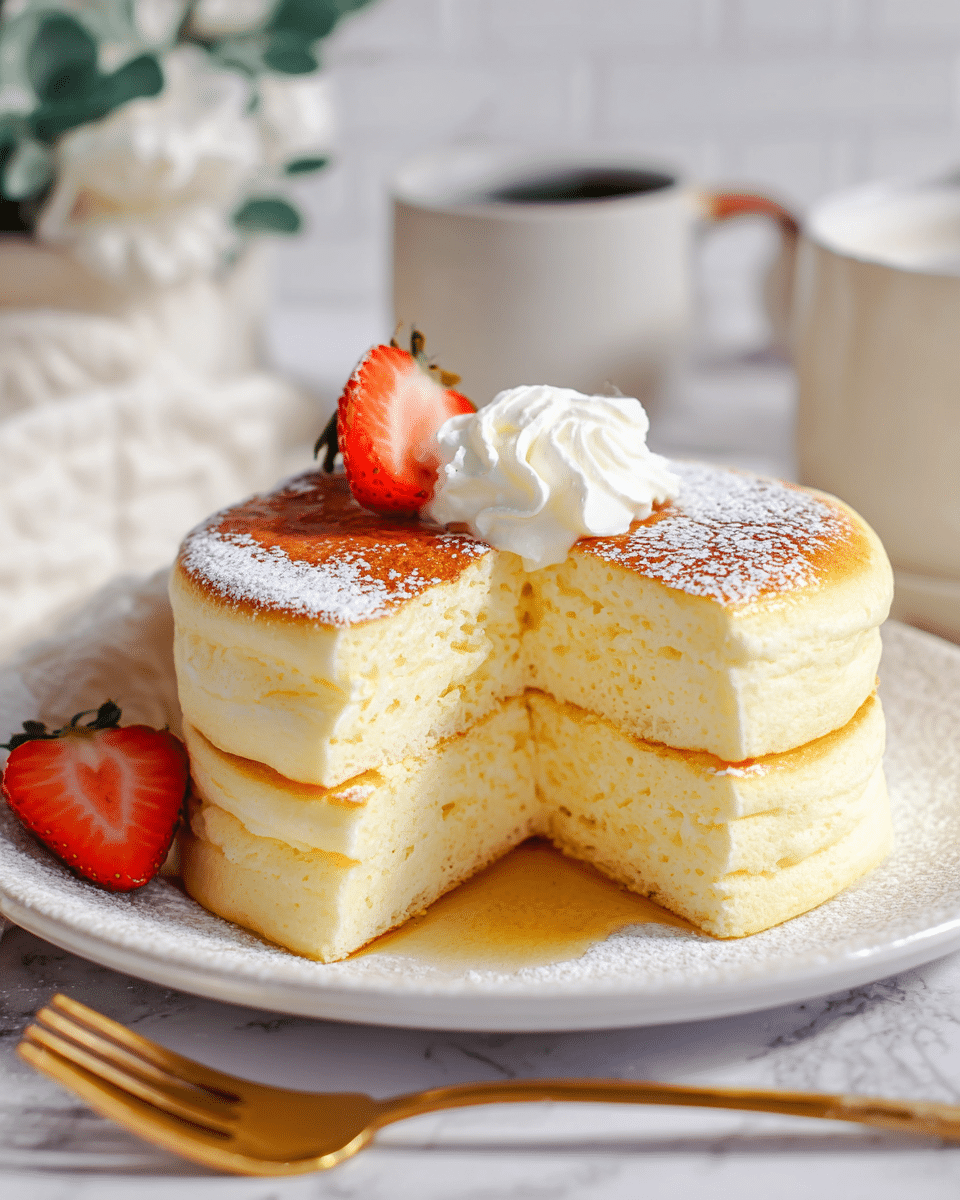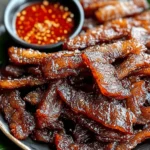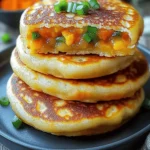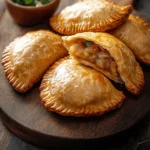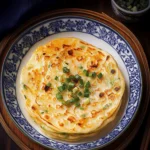The magic of Japanese soufflé pancakes lies in their incredible fluffiness and signature jiggle. Unlike traditional pancakes, these are made by delicately folding stiff meringue into a simple egg yolk batter, creating a texture that’s light as air and pillowy soft. With just a handful of ingredients, you can recreate this trendy café-style dish at home.
Perfect for breakfast, brunch, or a dreamy dessert, these soufflé pancakes are as fun to make as they are to eat. Topped with whipped cream, seasonal fruits, and a dusting of powdered sugar, they’re a picture perfect addition to your table. Don’t forget to serve them immediately these beauties deflate fast but stay delicious all the same!
Full Recipe:
Ingredients:
-
2 large eggs (separated into yolks and whites)
-
2 tablespoons milk
-
½ teaspoon vanilla extract
-
1 teaspoon lemon zest (optional)
-
¼ cup all-purpose flour (fluffed, spooned, and leveled)
-
¼ teaspoon baking powder
-
½ teaspoon white vinegar (or lemon juice)
-
2 tablespoons granulated sugar
-
Neutral oil, for greasing the pan
Optional Toppings:
-
½ cup heavy cream (cold)
-
1 tablespoon granulated sugar (or to taste)
-
½ teaspoon vanilla extract
-
Fresh fruits, powdered sugar, maple syrup
Directions:
-
Separate the egg whites and yolks carefully into two clean bowls.
-
To the yolks, add milk, vanilla extract, and lemon zest (if using). Whisk gently until smooth.
-
Sift in the flour and baking powder. Whisk until no dry flour remains. Set aside.
-
Add vinegar or lemon juice to the egg whites. Beat with a hand mixer on medium until frothy.
-
Slowly add sugar while mixing, then increase to medium-high speed and beat to stiff peaks.
-
Gently fold ⅓ of the meringue into the yolk batter until combined.
-
Add the remaining meringue and fold gently until no streaks remain. Do not overmix.
-
Heat a nonstick pan over low heat and lightly oil it.
-
Spoon or pipe the batter into tall mounds (2–3 pancakes).
-
Cover the pan and cook for 7–8 minutes. Carefully flip and cook for another 5–6 minutes.
-
Serve immediately with whipped cream, fruits, syrup, and a dusting of powdered sugar.
Optional Whipped Cream:
-
Combine cold cream, sugar, and vanilla in a bowl. Whip to firm peaks. Chill until ready to serve.
Prep Time: 7 minutes | Cooking Time: 13 minutes | Total Time: 20 minutes
Kcal: 375 kcal | Servings: 1 serving (2–3 pancakes)
The Allure of Japanese Soufflé Pancakes: A Fluffy Marvel of Modern Brunch Culture
Light, airy, jiggly, and irresistibly cute Japanese soufflé pancakes have taken the culinary world by storm. These dreamy pancakes, often stacked high and topped with clouds of whipped cream and vibrant fruit, offer more than just visual appeal. They’re a celebration of culinary finesse, rooted in precision and a deep understanding of technique. While they may resemble ordinary pancakes at first glance, one bite into these soft pillows quickly reveals the difference: soufflé pancakes are a hybrid of traditional griddle cakes and delicate French soufflés.
They’re not just food they’re a moment, a feeling, and often a viral video waiting to happen.
A Cultural and Culinary Origin Story
Japanese soufflé pancakes emerged as part of Japan’s love affair with Western-style desserts and “kawaii” (cute) culture. The country has a longstanding reputation for taking global food concepts and reimagining them with a unique twist. From cheesecake to curry, Japan often transforms everyday dishes into something delicate and refined.
The soufflé pancake likely originated from Tokyo cafes experimenting with Western brunch fare. It borrows heavily from French culinary techniques namely, the soufflé method of whipping egg whites to stiff peaks and carefully folding them into a yolk-based batter. This marriage of French technique and Japanese precision has produced a dish that’s part art, part science, and wholly delightful.
Today, cafes across Japan, and increasingly around the world, serve up these gravity-defying stacks. Their viral appeal on platforms like TikTok and Instagram has catapulted them to international fame, especially among foodies and brunch lovers who appreciate both flavor and form.
What Makes Them Different?
Unlike American-style pancakes that rely primarily on baking powder and soda for lift, soufflé pancakes use a meringue base whipped egg whites that trap air and expand during cooking. The result is a pancake that’s tall, spongy, and dramatically fluffy, with a signature jiggle that’s both fun and satisfying to watch.
When made correctly, Japanese soufflé pancakes don’t just look good they melt in your mouth. The exterior is lightly browned and delicate, while the inside stays tender and moist without being undercooked. It’s the kind of texture that seems almost magical, especially if you’re accustomed to the more substantial chew of traditional pancakes.
The Science Behind the Jiggle
At the heart of soufflé pancakes lies culinary science. Creating the perfect pancake depends on the integrity of the meringue. Egg whites, when whipped to stiff peaks, trap air and form a foam structure held together by protein strands. This foam is what gives the pancake its lift.
However, meringue is delicate. It can collapse if overwhipped, undermixed, or mixed too aggressively. Even the bowl or utensils used for whipping must be squeaky clean the presence of fat or oil can prevent egg whites from forming the structure needed.
Once the meringue is ready, it’s folded gently into the egg yolk and flour batter. This folding step is crucial. Mix too hard, and you’ll knock out all the air; mix too little, and your batter will be streaky and uneven. It’s this careful balance that defines the artistry of soufflé pancakes they are simple in ingredients but complex in execution.
Cooking Techniques and Challenges
Even with the perfect batter, soufflé pancakes are notoriously tricky to cook. They require low, controlled heat and plenty of patience. Unlike traditional pancakes that cook in a matter of minutes, soufflé pancakes need to be slowly steamed and cooked with the help of a lid, allowing heat to evenly distribute and gently set the batter.
The goal is to achieve a golden exterior while keeping the interior fully cooked but moist. Too high a temperature will brown the outside too quickly while leaving the inside raw. Too low, and the pancakes won’t rise properly. Most recipes recommend using an electric stovetop or a heavy-bottomed nonstick skillet with a lid to trap steam and regulate temperature.
Another challenge is flipping. Because the pancakes are so delicate and airy, turning them requires a careful hand. Use too much force or flip too early, and you risk collapsing the structure.
Tips for Success
Here are several key tips to increase your odds of success when making Japanese soufflé pancakes:
-
Use room-temperature eggs. They whip up better and more consistently than cold ones.
-
Add vinegar or lemon juice to the egg whites. This helps stabilize the meringue and maintain structure.
-
Be patient when cooking. Low and slow is the way to go.
-
Don’t peek too often. Keeping the lid on helps steam the pancakes evenly.
-
Serve immediately. Soufflé pancakes start to deflate after cooking, so plating them promptly is essential to preserving their height and appeal.
Popular Variations and Toppings
While the classic soufflé pancake is lightly sweetened and flavored with vanilla, there are endless variations to explore. Some popular versions include:
-
Matcha Soufflé Pancakes: Incorporating matcha powder into the batter for a grassy, slightly bitter contrast.
-
Chocolate or Cocoa Pancakes: Richer in flavor, often served with a drizzle of chocolate ganache.
-
Strawberry Shortcake Style: Topped with fresh strawberries, whipped cream, and powdered sugar.
-
Honey Butter or Maple Syrup: A simple topping that lets the pancake’s texture shine.
Toppings play a huge role in the overall presentation. From artistic fruit arrangements to edible flowers, each plate becomes a small masterpiece. Many cafes treat soufflé pancakes like a canvas for culinary creativity.
The Experience of Eating One
There’s something whimsical about slicing into a soufflé pancake. Your fork meets just a slight resistance before gliding through layers of fluffy interior. It’s reminiscent of cutting into sponge cake but with the warm comfort of a griddle cooked breakfast.
The texture soft, slightly chewy, yet airy is what makes this dish addictive. Paired with the richness of cream or the acidity of fruit, it strikes a balance that’s deeply satisfying. The taste is subtly eggy but not overwhelming, making it appealing to a wide range of palates.
Common Pitfalls and How to Avoid Them
Despite their beauty, soufflé pancakes are not the easiest breakfast item to make. Here are some common problems:
-
Flat Pancakes: Usually due to overmixing or deflated meringue.
-
Raw Centers: A result of too much heat or insufficient cook time. Cook low and covered.
-
Collapsing After Cooking: Some deflation is normal, but major collapse may indicate overwhipping or improper folding.
-
Sticky Surface: Often from not wiping excess oil in the pan or covering the pan incorrectly.
Mastering soufflé pancakes might take a few attempts, but the rewards both visual and edible are worth the effort.
Conclusion:
Japanese soufflé pancakes are more than a food trend they are a showcase of what happens when culinary technique, science, and artistry converge. Making them is a lesson in patience, precision, and care, but the result is something truly extraordinary. Whether you’re a home cook looking to impress brunch guests or a food lover in search of a new challenge, soufflé pancakes offer a delightful journey from batter to plate.
They remind us that sometimes the simplest ingredients eggs, flour, milk, sugar can yield the most magical results when treated with skill and intention. Their viral popularity is no accident. These pancakes are the kind of dish that engages all the senses: from the jiggle on the plate to the melt in your mouth texture and their picture perfect presentation.
So next time you’re in the mood for something a little different for breakfast or brunch, give Japanese soufflé pancakes a try. You might just fall in love with their charm, both in the making and the eating.

